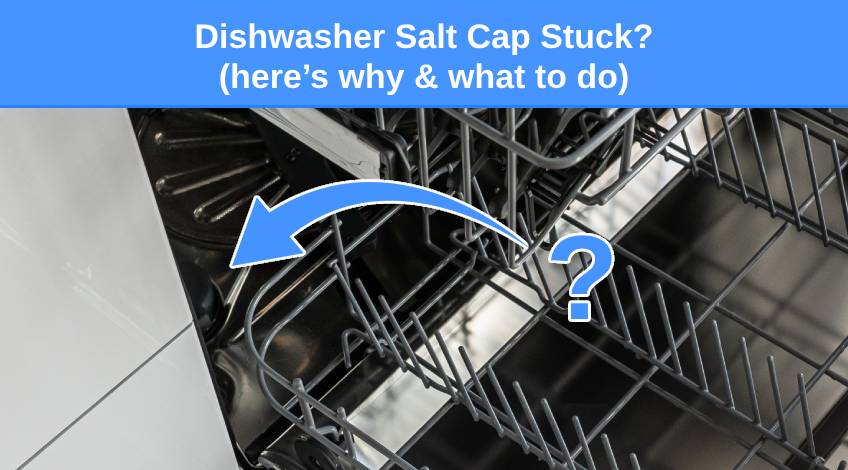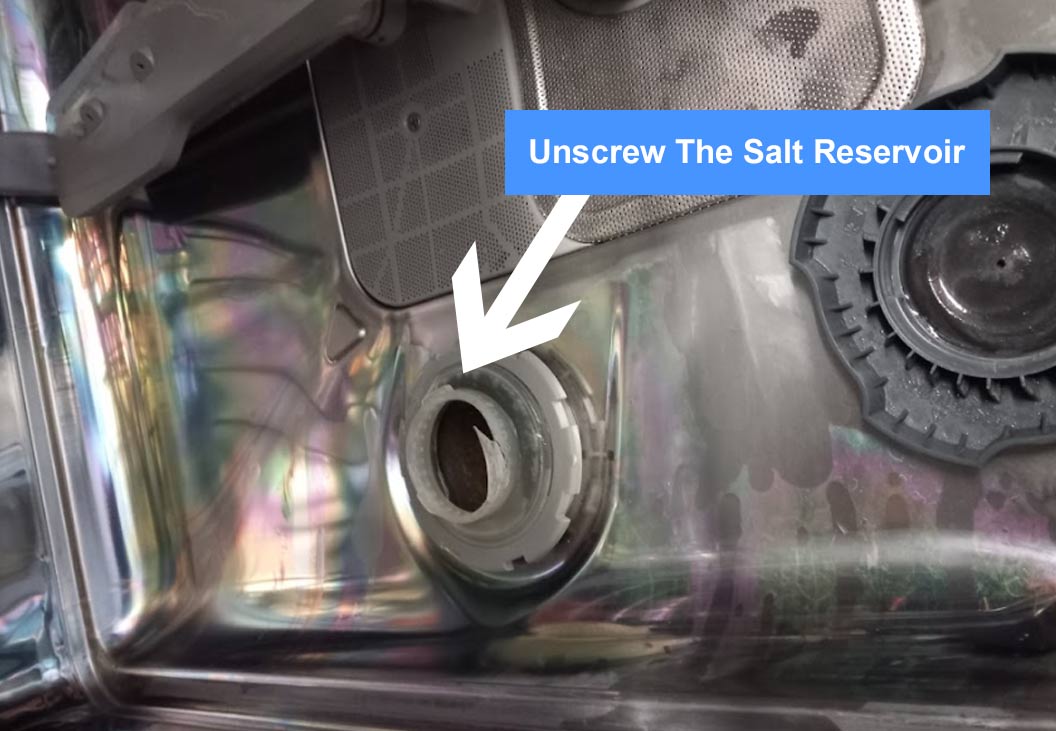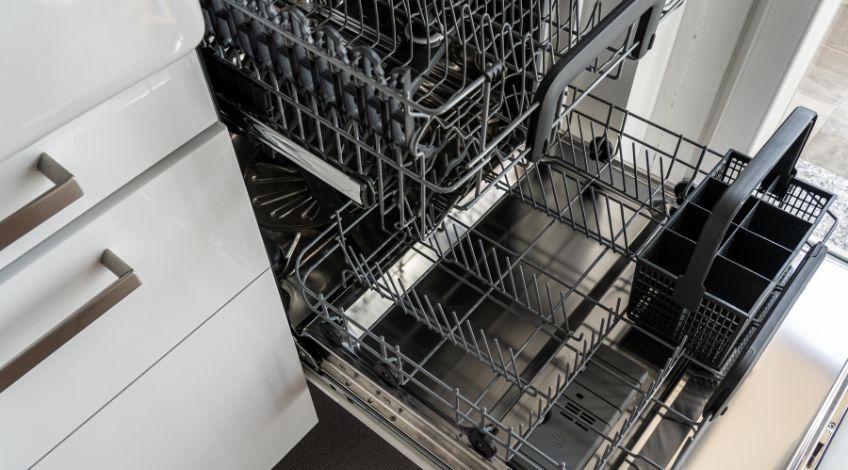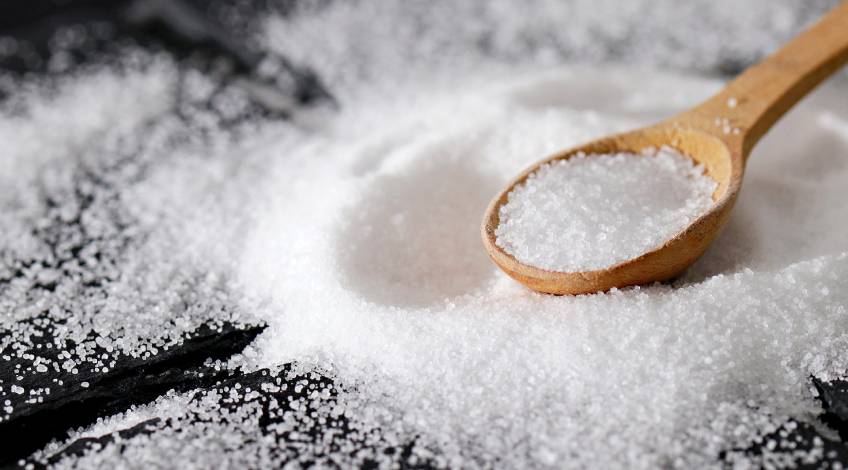
Dishwasher Salt Cap Stuck? (here’s why & what to do)
It’s important to keep the salt reservoir on your dishwasher topped up to help prevent limescale buildup and soften the water. This ensures that your detergent performs better and helps to prevent white streaks on glasses and dishes.
But what do you do if the salt cap is stuck? In this article we look at the various ways you can remove the salt cap from your salt reservoir if it gets stuck.
What Causes The Salt Cap To Get Stuck?
The salt cap on your salt reservoir needs to be tightened properly to prevent the salt from spilling onto the dishes and getting washed away. However, it can often get stuck by encrusted salt which prevents the cap from twisting.
This is because dishwasher salt is coarse salt which is thicker than regular salt and it also contains no anti-caking agents which means it’s more likely to stick together and harden.
If the salt hardens on the underside of the cap, it can seal the cap tight. There’s also the possibility that you have over tightened the cap when filling the salt reservoir.
How To Unscrew The Salt Reservoir Cap

There are a few things you can do to help loosen the salt cap on your dishwasher. These include;
Ensure You’re Twisting The Cap The Correct Way
This is one of the most commonly reported reasons for the salt cap not twisting off. Some salt caps have an arrow that indicates the way you need to turn it to open it. However, not all of them have any indicator at all.
You usually turn the lid in a clockwise direction to tighten it and in an anti-clockwise direction to loosen it.
Use A Hot Cloth
If the cause is salt encrusted around the cap’s thread, you’ll need to use a cloth soaked in hot water. All you do is take the hot water soaked cloth and cover the salt cap with the cloth.
Once the cloth has cooled down, try twisting the cap backwards and forwards to loosen it. If you don’t have any success with this method the first time, repeat the process.
If this doesn’t work after 2 or 3 attempts, try pouring hot water directly from the kettle onto the cap and allowing it to cool before trying to unscrew the cap again.
Use A Salt Cap Spanner
Even if the salt cap isn’t stuck with encrusted salt, it can be difficult to twist especially if you have arthritis or other issues. To combat this you can purchase a salt cap spanner.
SMEG Dishwasher Salt Cap Spanner
- Makes salt compartment cap easy to remove - even when stuck fast!
- Saves calling out an engineer or damaging the cap
This particular salt cap spanner is designed specifically for SMEG dishwashers.
Siemens, Bosch, Neff Dishwasher Salt Cap Spanner
- Makes salt compartment cap easy to remove - even when stuck fast - check our reviews!
- Lightweight durable construction - eco friendly, durable 3D printed PLA for a precise fit. Designed and manufactured in the UK.
This salt cap spanner is designed for Siemens, Bosch, Neff and other similar dishwasher salt caps.
Kenwood, Baumatic & Rangemaster Dishwasher Salt Cap Spanner
- Makes salt compartment cap easy to remove - even when stuck fast - saves calling out an engineer or damaging the cap
- Lightweight durable construction - eco friendly, durable 3D printed PLA for a precise fit, check pictures for fitment
This salt cap spanner is designed for use with Baumatic, Kenwood, Rangemaster and other compatible machines.
All of the above dishwasher salt cap spanners are relatively cheap and take all of the struggle out of removing the salt cap on your dishwasher. Just ensure you get the correct spanner for your appliance.
If the salt cap often gets stuck on your dishwasher, it’s well worth investing in one of these cap spanners. This could make filling the salt reservoir a much easier task in future.
Why Is There Water In The Salt Reservoir?

When you finally get your salt cap off you might find that all you can see is water in the reservoir. This is quite normal and not a cause for concern.
The salt mixes with water in the reservoir as part of the water softening process. As you pour salt into the reservoir, excess water will spill out. This is perfectly normal and doesn’t mean there’s a problem with your appliance.
When you first use your dishwasher you will need to fill the reservoir with water and then add salt. After that, all you’ll ever need to add to the reservoir is salt.
How Often Does The Salt Reservoir Need Topping Up?
You should check the salt level in your dishwasher at least once a month. Some dishwashers have indicator lights that let you know when your salt reservoir needs to be topped up.
But you should get into the habit of checking your salt reservoir at least once a month.
What Happens If You Don’t Refill The Salt Reservoir?
If you fail to refill the salt reservoir regularly, you will soon start to notice a buildup of limescale. This will lead to white streaks on your glasses and dishes.
If you use all in one dishwasher tablets or pods, you don’t need to add salt. However, if you notice white streaks or stains on your glasses or dishes, we recommend using dishwasher salt anyway. This will protect your appliance from limescale buildup and keep your glasses and dishes sparkling clean.
Can I Use Table Salt In My Dishwasher?

Table salt is sodium chloride which is the same chemical that makes up dishwasher salts. Which might lead you to think it’s OK to use table salt in your dishwasher.
We wouldn’t recommend it however because table salt is much finer than dishwasher salt which means it could block and damage your dishwasher.
Dishwasher salt has larger size granules which will dissolve slower without causing any blockages to the softener unit.
SEE ALSO: How Much Salt Do I Put In A Dishwasher? (the real answer)
Frequently Asked Questions
It’s quite normal for the salt compartment on the dishwasher to be full of water. The dishwasher salt mixes with the water to create a brine solution which acts as a water softener.
Table salt is too fine for use in a dishwasher and could cause a blockage or damage to the softening unit.
If the salt cap on your dishwasher is stuck, try soaking a cloth in hot water and covering the salt cap with the cloth. Allow it to cool and then try twisting the cap backwards and forwards gently. If this doesn’t work, try pouring hot water from your kettle onto the cap and allow it to cool before trying to twist the cap. If all else fails, invest in a dishwasher salt cap spanner.
Also, follow us on Pinterest ...






